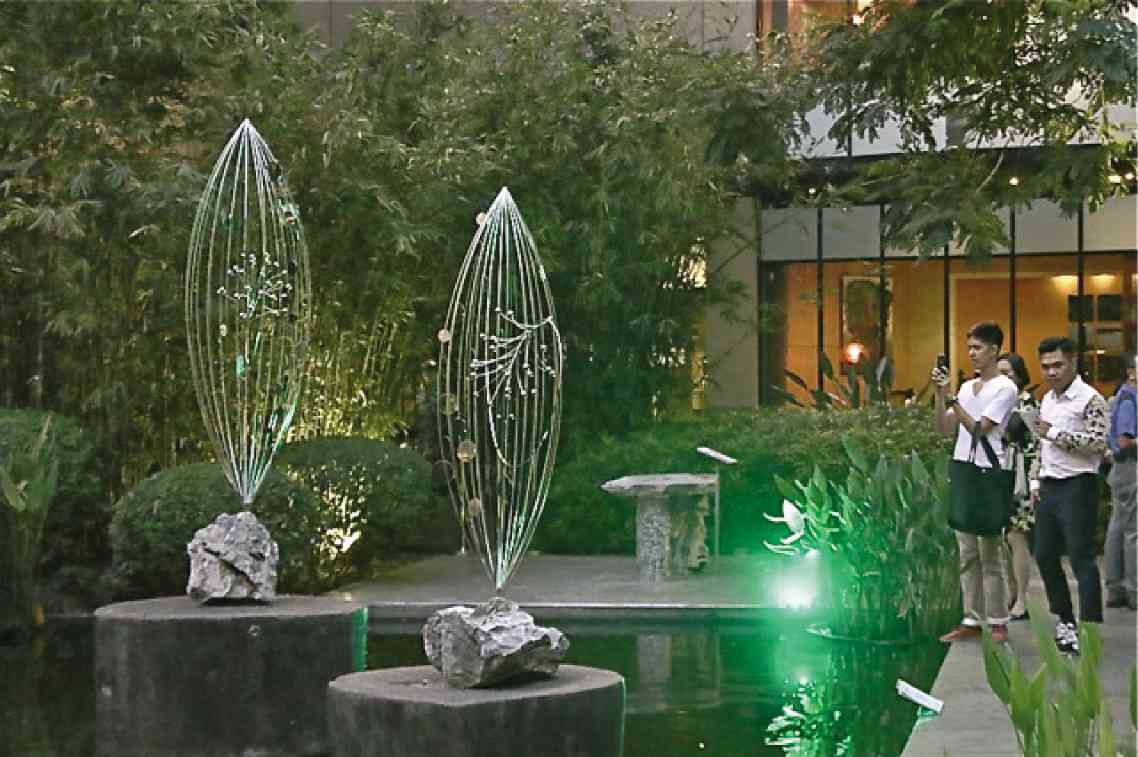They look like colorful cells that pop up from the earth. Painted in orange, acid green and violet, these stainless steel stools beckon passersby.
“Look, a family is having its picture taken with them,” says sculptor Impy Pilapil as she refers to her outdoor installation, “Bursts of Spring.”
“My work is like wild blooms that sprout from the ground. Even if the family doesn’t understand it, at least they felt something good and they want to be with it.”
The installation is part of “New Life,” Pilapil’s exhibit on view at the gardens of Greenbelt malls.
As in her previous works, she takes to the solidity of stone, the royalty of marble, the lightness of steel and the transparency of acrylic. The shapes are always organic and fluid, outlined with rounded corners, never any hard edges.
Truths through observation
Pilapil’s works have been influenced by Austrian philosopher and polymath Rudolf Steiner (1861-1925), who developed “anthroposophy,” which teaches that people can discover truths through research and observation. It encompasses metaphysics, natural science and art.
Those who have followed Steiner include artists Piet Mondrian, Wassily Kandinsky and architect Richard Neutra; they believed that the arts could make indefinable, spiritual laws comprehensible to the senses. As a result, their works have taken an organic character.
Pilapil interprets Steiner’s teachings through the themes of her works. They’re all about life and nature thus the prevalence of cellular shapes, pistils in steel, seeds and pods and ocean waves.
Ten-foot-tall stainless steel installations suggest soft clouds of mists with sparkling balls that represent droplets of water hanging in the air.
Bringing art outdoors
Believing like Steiner that art should appeal to the full senses, Pilapil brings her work from the gallery to the outdoors. Some are mobile cells that dangle from the tall trees. Others feature little balls that wiggle from the springs.
A stainless steel sculpture, “The Sense of I,” becomes a mirror where the viewer can see the self and appreciate the uniqueness of others.
“People have been living in intense materialism. I want to wake them up,” she says.
Pilapil insists that art should have soul to be able to touch lives. She adds she is often appalled at how art is commoditized when people discuss prices rather than aesthetics. “The purpose of art is to serve higher ideals,” she says.
The artist was attracted to Steiner’s way of personal development. “He wants you to discover yourself in what you suggest for yourself to study and to learn. In the process, I became more aware and disciplined. When I was younger, I thought more about me and art as self-expression. ‘This is me.’ Now my art is created along with how it would serve the viewer, or how to elevate his thinking and feeling. When people say a work is beautiful, it touches their sensibility.”
Following Steiner’s precept of freedom, Pilapil set her installations around Greenbelt for people to interact with. “In my heart, it was like an offering. I wanted them to look at art without the inhibitions of being in a gallery. I wanted them to feel at home with art in a public place,” she says.
Artworks destroyed
Despite Pilapil’s noble intentions, people have been abusive. She recalls that before the opening of the exhibit, “Mangrove,” a series of green loops adorned with balls, was damaged.
It took 30 people to put up the acrylic mobiles on the trees in Greenbelt’s pebble garden. People tried climbing up and touching them. Sometimes they would throw stones at the works with concave surfaces.
The “Wish Stone,” a table made with Romblon marble, was meant to be like a sacred altar. It became a dumping place for fast-food garbage. One day, a nanny even used it as a place to change an infant’s diapers.
One installation resembles skeletal pods with pistils waiting to germinate. They spring from rocks on the pond. It is titled “Life Is Always Reaching Out to Remind Us to Stop Awhile and Listen.” A middle-age lady took it literally by jumping over the pond, stepping on a rock and having a selfie taken.
In “Waterfall,” a stainless steel installation that evokes a vertical rush of water with droplets all around, people dare pick out the balls.
“They get interested in the shiny objects and pull them out. I don’t think they are consciously stealing, but they are challenged to remove them. Then they bring it home,” she observes.
In exasperation, Silvana Diaz, owner of Galleria Duemila, the organizer and curator of the exhibit, placed stanchions in front of the stainless steel works.
In contrast, she points out how her welder from Bulacan had been proud of participating in the show. On a Sunday, his seven-year-old son came to defend the sculptures from the affluent children who were throwing stones.
“He pleaded with them not to harm the pieces. Why does this boy have the sensibility and the other kids feel they have the right to destroy?” asks Pilapil.
Waxing philosophical, she remarks, “I don’t want to judge them as vandals. They are just curious and want to bring home a memento. That is how they get educated. I have to hold myself back and look at the bigger picture.”









































